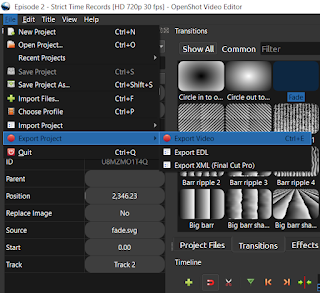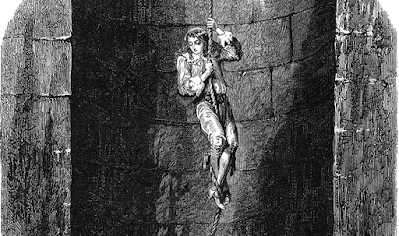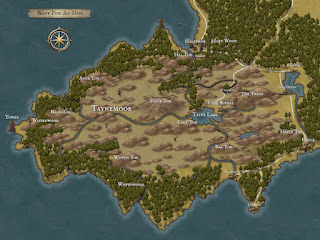I've been asked a couple times by podcasters aspiring to jump to YouTube about the waveform videos I make. Trying to be helpful - a while back - I'd taken some screenshots while making one and sent them alongside my current process for making them. From there, I figured I'd share those same screenshots here - in the event that I run into someone who likewise wants to start doing waveform companion videos to podcast episodes.
Bit of a break from the normal RPG supplemental stuff I post - but I hope it helps: and for next week, I'm working on a new B/X small dungeon. Thanks for reading!
Assumptions
I use OpenShot to make videos: an open source video editing program for Mac, Windows, and Linux. I have not particular fondness or attachment to OpenShot - it was simply the highest rated free or open source program at the time when I started making videos. The reason I bring it up, because that's what I'm using, that's where the screen captures will come from and that's the program I can give (limited) advice on fiddling with, as it's the only one I've really used.
Additionally, I use (presently, at least) the Anchor platform to host and to record while on the road, afterward downloading segments from the Anchor web site and using Audacity to introduce sound effects, equalize the volume, and tie the segments together: exporting the final product as a single MP3 file. Again, no attachment to to software - it was what my friends were using and (again) free: so I ran with it. The reason I bring it up - part of my process is to produce the audio first: and from there, having the file, I can load that directly into the OpenShot project rather than using OpenShot, itself, to edit or produce the recording.
I do use OpenShot on the actual play and panel/interview style podcast episodes on the CWR YouTube channel - however, that's outside the scope of what I'm trying to accomplish with this guide.
Process
1. Launch OpenShot and Load Files
Launch the OpenShot editor and, in the Project Files tab, load up (associate, truthfully - it creates a pointer to the assets on disk rather than cloning them: but that's not important right now) the audio file to be wave-formed and any supporting icons or images (legalese, screen captures, icons and logos, ...) you want to include.
2. Drag the Audio File onto a Track
Drag and drop the audio file to be wave-formed onto a track of your choosing.
If you have icons, logos, or other overlays, I recommend putting the audio
track on the bottom, Track 1 - so that the icons, logos, etc. display above
it. However - don't worry too much - you can drag and drop to a new at any
time.
Note the position of the blue cursor on the track panel, or possibly
the position of a little green cursor on the selected content. It's important
that you're at the beginning of the selected segment - as if you're in the
middle, there is a chance OpenShot will think the changes you're making should
take effect at that point instead of the beginning - so, if you change colors,
change widths, etc. - as I'm about to mention, it will do it (and the preview
will show it) but then if you watch the video, it will fade to the default
color, shrink to the default width, and so on, because it thought the thing
you did was only for the place the cursor is. It automatically inserts a
transition effect between the previous control point and the current one
instead of applying the change to the whole element.
There is likely more science behind this - and someone more versed with the UI can speak to it more intelligibly - but I, being a rank amateur, have found a workaround - which I'm now telling you about: hoping that you may avoid the same hiccups I experienced.
3. Set Visual Properties of Audio Segment
Having dragged/dropped the audio segment, the left menu will - typically - automatically show properties of that segment. If it does not, you can right click the segment and select "properties" to bring it up. The three properties that I set are as follow:
|
1. Set Scale to "Stretch" This will make the waveform take up the whole screen rather than boxing itself in with margins. |
|
|
2. Set Wave Color to taste. This is the color of the waveform that will generate. I use orange to run with the theme that the blog uses. |
|
|
3. Set Waveform to "Yes". This actually generates the waveform and inserts it onto the studio deck. |
Waveform created! You can now move on with other stuff you want to include.
When You Export
A note to make - and this is somewhat outside the scope of the current document, but something that is very very important - when editing audio: make sure you're exporting at a quality appropriate to your target media.
To export the file, once editing is complete, you select File, then Export Project, then Export Video.
This will bring up the "Export Video" dialog. On this dialog are two tabs: Simple and Advanced - representing properties and profile for the video.
On the Simple properties, I always pick "Web" and "YouTube-HD." There are other options - BlueRay, Flikr, and so on - but I know I'm loading to YouTube: so YouTube-HD should be enough for me. The default value in the Profile drop down is "All" - do not use this. OpenShot will generate multiple files of multiple types destined to multiple players.
If you are releasing your podcast to DVD? Do it. Go right ahead.
But for most of us - a web profile optimized for the environment we're aiming to use as our destination consumer is a better bet.
Then, on the Advanced properties, you will need to scroll down and configure the Video Settings accordion. The video format will have been determined by your choice of destination on the Simple tab. For web videos, it tends to aim for MP4. This - or whatever the app decides - is fine: however, you're going to want to consider the Bit Rate / Quality value of the export you're making.
Note - like I have already said - I am a rank amateur.
While I understand what "bit rate" means and I know what the unit of measure represents - I am not a videographer, I am not a cinephile - so the impact of one bit rate over another, I don't know what it implies or entails for the experience of the end viewer. What I can tell you - the default value for YouTube-HD is 8 Mb/s - 8 Mb/s is entirely too high for a simple wave form - and will result in a multi-gigabyte file which will take literally half a day to export and another half a day to upload if you don't change it.
 |
| The same video file for the Warlock Tower: Part II actual play: exported as 8 Mb/s vs 2. |
So: what is the right bit rate for me? If you have actual video in your video - set the Bit Rate / Quality to the greatest bit rate (usually available in the file properties of the segment you've included: same place as where you'd find the file name, file size, date created, and so on) among these. So, if you have three video segments - one at 1.5 Mb/s (which is about what OBS usually exports when I use it), one at 4 Mb/s, and one at 2.25 Mb/s - you would want to set this value to 4 Mb/s so as to prevent loss of quality on the larger segment. If you're good with quality loss on child segments? You're welcome to set it lower.
What about if I'm all audio all the time? Or maybe just audio with some images and minimal transitions? This use case is 90% of my use cases. To that end - I've found that 2 Mb/s maintains the crispness of the images and motion involved with transitions and moving waveform.
You Now Have a Companion Waveform Video!
Load 'er up and you're ready to go.
Hopefully this helps - hopefully it was as interesting as I had intended for it to be informative - and, if you're out there and you know better than I am what any of this all means, please pipe up and correct the errors and omissions that I've made. Alternatively, if there are other guides - more succinct or more verbose; more inclusive or more focused - feel free to link those too! I still feel like I don't know what I'm doing in the video universe and am open to learn!
Similarly - if there's something I've missed that you want to know - feel free to ask! I read all the comments - sometimes it takes a while to reply, but I will not forget to reply - and I'll do my best to swing back by, tell you what I know or look up what I don't, and keep things moving for anyone who is interested.
Thank you for reading - and delve on!

























